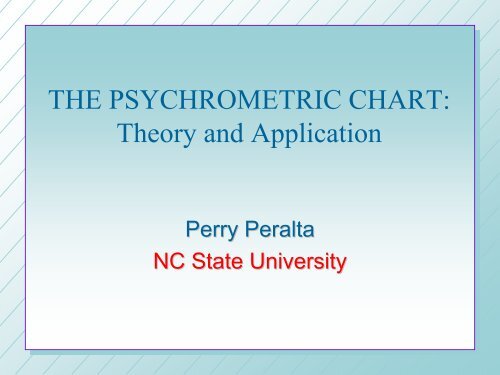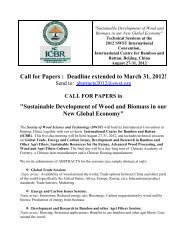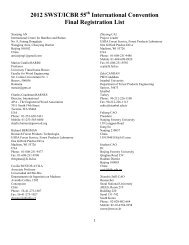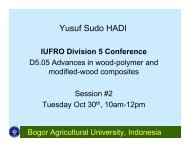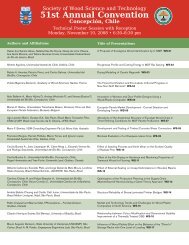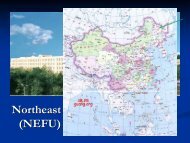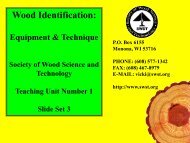THE PSYCHROMETRIC CHART: Theory and Application
THE PSYCHROMETRIC CHART: Theory and Application
THE PSYCHROMETRIC CHART: Theory and Application
Create successful ePaper yourself
Turn your PDF publications into a flip-book with our unique Google optimized e-Paper software.
<strong>THE</strong> <strong>PSYCHROMETRIC</strong> <strong>CHART</strong>:<br />
<strong>Theory</strong> <strong>and</strong> <strong>Application</strong><br />
Perry Peralta<br />
NC State University
<strong>PSYCHROMETRIC</strong> <strong>CHART</strong><br />
Identify parts of the chart<br />
Determine moist air properties<br />
Use chart to analyze processes<br />
involving moist air
Psychrometric chart: Example 1<br />
Given: T = 25°C<br />
T w =20°C<br />
Required: (a) RH, (b) T dp , (c) HR, (d) v, (e) h
57.5 kJ/kg d.a.<br />
20.0°C<br />
25°C<br />
63%<br />
17.6°C 12.6 g/kg d.a.<br />
0.86 m 3 /kg d.a.
<strong>PSYCHROMETRIC</strong> PROCESSES
Sensible Heating or Cooling<br />
a psychrometric process that involves<br />
the increase or decrease in the<br />
temperature of air without changing its<br />
humidity ratio<br />
Example: passing moist air over a room<br />
space heater <strong>and</strong> of kiln air over the<br />
heating coils
1 2
Sensible heating: Example 5
T 2 =60ºC<br />
T w2 =50ºC<br />
RH 2 =58.8%<br />
T 3 =70ºC<br />
T w3 =?<br />
RH 3 =?
287.0 kJ/kg d.a.<br />
275.5 kJ/kg d.a.<br />
50°C<br />
51°C<br />
58.8%<br />
2 3<br />
37.6%<br />
60°C 70°C
Heating <strong>and</strong> Humidifying<br />
a psychrometric process that involves<br />
the simultaneous increase in both the<br />
dry bulb temperature <strong>and</strong> humidity ratio<br />
of the air
1<br />
2<br />
0
Heating <strong>and</strong> humidifying: Example 7<br />
Two <strong>and</strong> a half cubic meters of lumber is being dried<br />
at 60°C dry bulb temperature <strong>and</strong> 52°C wet bulb<br />
temperature. The drying rate of the lumber is 12.5<br />
kg of water per hour. If outside air is at 27°C<br />
dry bulb temperature <strong>and</strong> 80% relative humidity,<br />
how much outside air is needed per minute to carry<br />
away the evaporated moisture?
52°C<br />
1<br />
80%<br />
2<br />
27°C 60°C<br />
0.87 m 3 /kg d.a.<br />
92 g/kg d.a.<br />
18 g/kg d.a.
Heating <strong>and</strong> humidifying: Example 7<br />
∆HR = (92.0 – 18.0) g/kg dry air<br />
= 74.0 g/kg dry air<br />
w a1 = drying rate/∆HR<br />
= (12.5 kg/hour)/(0.074 kg/kg dry air)<br />
= 168.9 kg dry air/hour<br />
VF 1 =(w a1 )(v 1 )<br />
=(168.9 kg dry air/hour)(0.87 m 3 /kg dry air)<br />
= 147 m 3 /hour = 2.45 m 3 /minute
Cooling <strong>and</strong> Dehumidifying<br />
a psychrometric process that involves<br />
the removal of water from the air as the<br />
air temperature falls below the dewpoint<br />
temperature
2<br />
1
Cooling <strong>and</strong> dehumidifying: Example 9<br />
Moist air at 50°C dry bulb temperature <strong>and</strong> 32%<br />
relative humidity enters the cooling coil of a<br />
dehumidification kiln heat pump system <strong>and</strong> is<br />
cooled to a temperature of 18°C. If the drying rate<br />
of 6 m 3 of red oak lumber is 4 kg/hour,<br />
determine the kW of refrigeration required.
50.8 kJ/kg d.a.<br />
115.7 kJ/kg d.a.<br />
28.8°C<br />
2<br />
32%<br />
18°C 50°C<br />
1<br />
25.2 g/kg d.a.<br />
12.9 g/kg d.a.
Cooling <strong>and</strong> dehumidifying: Example 9<br />
∆HR = (25.2 – 12.9) g water/kg dry air<br />
= 12.3 g water/kg dry air<br />
w<br />
a<br />
drying rate<br />
=<br />
∆HR<br />
4<br />
kg water<br />
=<br />
h<br />
0.0123<br />
kg water<br />
kg dry air<br />
kg dry air<br />
= 325.2<br />
h
Cooling <strong>and</strong> dehumidifying: Example 9<br />
∆h = (115.7 – 50.8) kJ/kg dry air<br />
= 64.9 kJ/kg dry air<br />
q = ∆h<br />
w<br />
( )( )<br />
a<br />
⎡ kJ ⎤⎡kg dry air ⎤<br />
= ⎢64.9 325.2<br />
kg dry air<br />
⎥⎢h ⎥<br />
⎣ ⎦⎣<br />
⎦<br />
kJ<br />
= 21105.7 = 5.9 kW<br />
h
Adiabatic or Evaporative Cooling<br />
a psychrometric process that involves<br />
the cooling of air without heat loss or<br />
gain. Sensible heat lost by the air is<br />
converted to latent heat in the added<br />
water vapor
2<br />
1
Evaporative cooling: Example 10<br />
Referring to Figure 21, air at state point 1 (65°C<br />
dry bulb temperature <strong>and</strong> 57°C wet bulb temperature)<br />
experiences a temperature drop of 3°C as it passes<br />
through the 1.2-m wide stack of lumber. Determine<br />
the properties of the air at state point 2 <strong>and</strong> compare<br />
them with those at state point 1. If the air is flowing<br />
at a rate of 2 meters per second, determine the drying<br />
rate assuming that the volume of the stack of<br />
2.5-cm-thick lumber is 2.5 m 3 . The stack is<br />
1.2 m wide x 3.6 m long, <strong>and</strong> the boards are<br />
separated by stickers 3.8 cm wide x 1.9 cm thick that are<br />
spaced 0.6 m apart.
T=65ºC<br />
T w =57ºC<br />
T=62ºC
Evaporative cooling: Example 10<br />
Given: T1 = 65°C; Tw1 = 57°C<br />
Adiabatic cooling to T2 = 62°C<br />
Air flow rate = 2 m/s<br />
Volume of lumber = 2.5 m3 Board thickness = 2.5 cm<br />
Stack dimensions: 1.2 m wide x 3.6 m long<br />
Sticker dimensions: 3.8 cm wide x 1.9 cm thick<br />
Sticker spacing = 0.6 m<br />
Required: (a) Properties of the air at state point 2<br />
relative to that at state point 1<br />
(b) Drying rate<br />
Solution:
57°C<br />
2<br />
62°C<br />
65°C<br />
1<br />
1.14 m 3 /kg d.a.<br />
124.5 g/kg d.a.<br />
123.1 g/kg d.a.<br />
1.15 m 3 /kg d.a.
Evaporative cooling: Example 10<br />
(a) At state point 1: T 1 = 65°C<br />
T w1 = 57°C<br />
T dp1 = 56.3°C<br />
RH 1 = 66.9%<br />
HR 1 = 123.1 g/kg of dry air<br />
v 1 = 1.15 m 3 /kg of dry air<br />
h 1 = 387.7 kJ/kg of dry air<br />
At state point 2: T 2 = 62°C<br />
T w2 = 57°C<br />
T dp2 = 56.5°C<br />
RH 2 = 77.3%<br />
HR 2 = 124.5 g/kg of dry air<br />
v 2 = 1.14 m 3 /kg of dry air<br />
h 2 = 387.7 kJ/kg of dry air
Evaporative cooling: Example 10<br />
Drying rate = ∆HR<br />
w<br />
(b) ( )( )<br />
VF<br />
w= a<br />
v2<br />
VF = ( A)( air flow rate)<br />
a
Evaporative cooling: Example 10<br />
⎛ V ⎞⎛ Pl + S ⎞<br />
s<br />
A= ⎜ ⎟⎜Pl St − St Sw⎟<br />
⎝PP l w Bt ⎠⎝ Ss<br />
⎠<br />
⎛ 2.5 ⎞⎛ 3.6 + 0.6<br />
⎞<br />
A = ⎜ ⎟⎜3.6*0.019 − 0.019*0.038⎟<br />
⎝3.6*1.2*0.025 ⎠⎝ 0.6<br />
⎠<br />
2<br />
A= 1.47m
Evaporative cooling: Example 10<br />
2<br />
A= 1.47m<br />
VF = ( A)( air flow rate)<br />
( 3 )<br />
⎛ m⎞ m<br />
VF = 1.47m ⎜2 ⎟=<br />
2.9<br />
⎝ s ⎠ s<br />
3
Evaporative cooling: Example 10<br />
3<br />
m<br />
VF =2.9<br />
s<br />
VF<br />
w= a<br />
v2<br />
3<br />
m<br />
2.9<br />
kg dry air<br />
w s<br />
a = = 2.6<br />
3<br />
m s<br />
1.14<br />
kg dry air
Evaporative cooling: Example 10<br />
kg dry air<br />
wa= 2.6<br />
s<br />
Drying rate = w ∆HR<br />
( )( )<br />
a<br />
⎛ kg dry air ⎞⎛g⎞<br />
Drying rate = ⎜2.6 ⎟⎜1.4 s kg dry air<br />
⎟<br />
⎝ ⎠⎝⎠ g kg<br />
= 3.6 = 13.0<br />
s h
Adiabatic Mixing of Moist Air<br />
Stream<br />
A psychrometric process that involves<br />
no net heat loss or gain during the<br />
mixing of two air streams
1<br />
3<br />
2
Adiabatic mixing: Example 11
T 3 =43.3ºC<br />
T w3 =37.8ºC<br />
T2 =26.7ºC<br />
RH2 =80%<br />
VF2 =28 m3 /min<br />
T1 =43.3ºC<br />
Tw1 =37.8ºC<br />
VF1 =112 m3 /min
80%<br />
37.8°C<br />
2<br />
26.7°C<br />
3<br />
1<br />
43.3°C<br />
0.87 m 3 /kg d.a.<br />
0.95 m 3 /kg d.a.
Adiabatic mixing: Example 11<br />
VF<br />
w= a<br />
v<br />
3<br />
m<br />
112<br />
kg dry air<br />
w minute<br />
a1 = = 117.9<br />
3<br />
m minute<br />
0.95<br />
kg dry air<br />
3<br />
m<br />
28<br />
kg dry air<br />
w minute<br />
a2 = =<br />
32.2<br />
3<br />
m minute<br />
0.87<br />
kg dry air
Adiabatic mixing: Example 11<br />
line 1-3 w 32.2<br />
= =<br />
line 1-2 w +w 32.2 117.9<br />
a2 = 0.21<br />
a2 a1 +<br />
Therefore, length of line segment 1-3 is 0.21 times<br />
the length of line 1-2
80%<br />
37.8°C<br />
35.6°C<br />
2<br />
26.7°C<br />
3<br />
40°C<br />
1<br />
0.87 m 3 /kg d.a.<br />
43.3°C<br />
0.95 m 3 /kg d.a.
Adiabatic mixing: Example 11<br />
T 3 = 40.0°C<br />
T w3 = 35.6°C


